Reducing Embodied Carbon in Construction: Insights and Policy Recommendations from the Essex Embodied Carbon Study
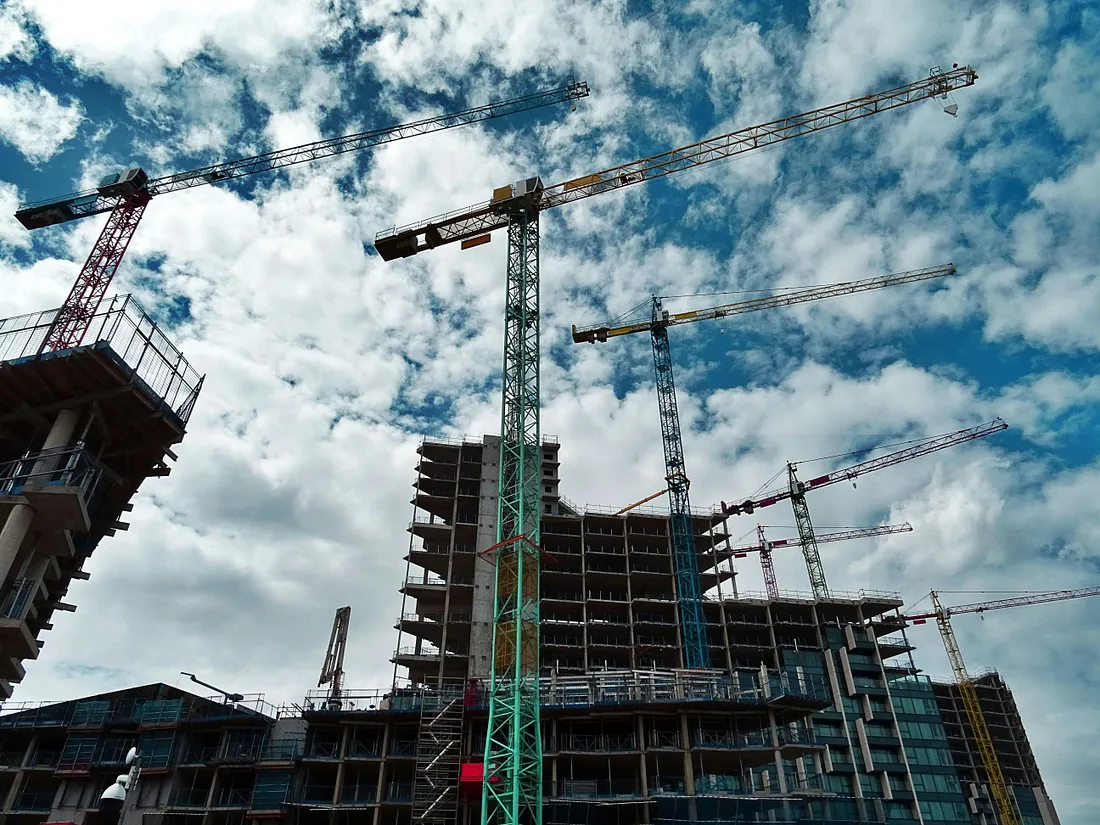
Image from Pexels
Introduction
As the world intensifies its fight against climate change, the construction industry is under increasing pressure to reduce its carbon footprint. A significant portion of this footprint is due to embodied carbon — the greenhouse gas emissions generated during the production, transportation, and assembly of building materials. This article dives into the critical importance of addressing embodied carbon in construction, explores current policies and industry guidelines, and outlines key recommendations for reducing these emissions. We will cover the urgency of implementing embodied carbon policies, explain what embodied carbon is, discuss its role in planning and design, review existing policies, and provide detailed policy recommendations. Additionally, we will explore how embodied carbon is integrated into the planning and design process, as well as how these policies can be effectively implemented to drive sustainable construction practices.
 Disclaimer: This article is a summary based on insights and findings from the Essex Embodied Carbon Policy Study, a comprehensive technical evidence base for developing planning policies aimed at reducing embodied carbon in construction.
Disclaimer: This article is a summary based on insights and findings from the Essex Embodied Carbon Policy Study, a comprehensive technical evidence base for developing planning policies aimed at reducing embodied carbon in construction.
1. The Urgency for Embodied Carbon Policies
Global Climate Emergency Overview
The report underscores the urgent need for global action on climate change, with overwhelming scientific consensus confirming significant climate shifts. The 2023 IPCC Synthesis Report consolidates five years of data, highlighting the necessity of reducing global emissions by 43% by 2030 and at least 60% by 2035 to maintain the 1.5°C temperature rise limit. This decade is critical for achieving these targets, marking a decisive period in combating climate change.
National Commitment and the UK’s Net Zero Target
The UK’s commitment to addressing climate change is enshrined in the Climate Change Act 2008, updated in 2019, which mandates the country to achieve net zero carbon emissions by 2050. This commitment is structured through a system of carbon budgets, with the Climate Change Committee (CCC) setting a pathway for reducing emissions by 78% by 2035 compared to 1990 levels. The focus is not just on the final net zero target but on the rapid decarbonization required in the interim.
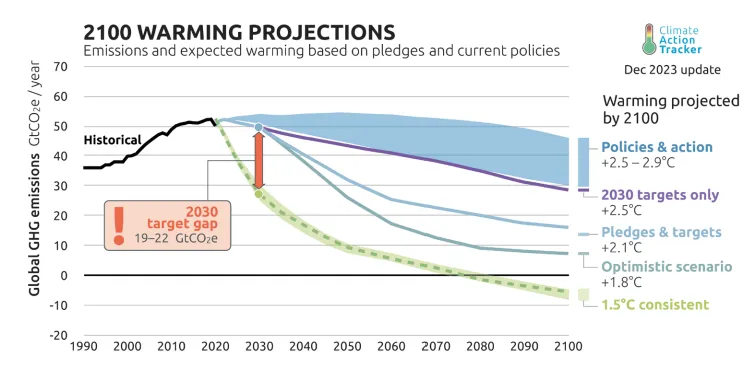
Global warming projections, highlighting the gap between the predicted temperature rise with policies and action (2.5–2.9oC) and the temperature rise above pre-industrial levels the IPCC recommends (1.5- 2.oC). A >1oC temperature rise has already been created. (Source: Climate Action Tracker, 2023)
The Role of Carbon Budgets
Carbon budgets are critical to the UK’s strategy, limiting the total greenhouse gases the country can emit over a five-year period. The sixth carbon budget, which includes emissions from UK-manufactured products but excludes those produced elsewhere for UK consumption, aims for a significant reduction by 2035. Local authorities are encouraged to adopt policies that consider embodied carbon, particularly in the construction sector, to help meet these targets and influence global decarbonization efforts.
Construction Industry’s Contribution to Carbon Emissions
The UK building construction industry is responsible for approximately 49% of the nation’s carbon emissions. These emissions are categorized into operational carbon (related to the energy use in buildings) and embodied carbon (associated with the materials and construction processes). As buildings become more energy-efficient, the proportion of embodied carbon in total emissions increases, highlighting the need for focused legislation on this aspect.
The Importance of Addressing Embodied Carbon
Embodied carbon now accounts for 40–70% of a building’s total lifecycle emissions, making it a critical focus area for meeting climate targets. Despite its significance, current UK building regulations do not sufficiently address embodied carbon. The UK Green Building Council estimates that embodied carbon contributes 40–50 million tonnes of CO2 annually, surpassing the emissions from aviation and shipping combined. Therefore, new policies are essential to tackle these emissions and transition towards a circular economy.
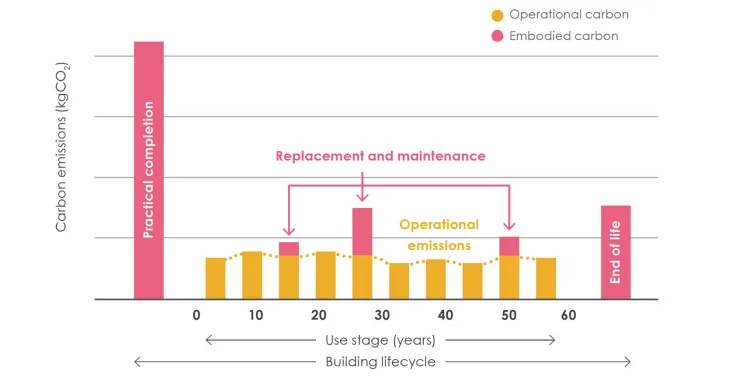
Interaction between operational and embodied carbon throughout the lifetime of a building (Source: LETI)
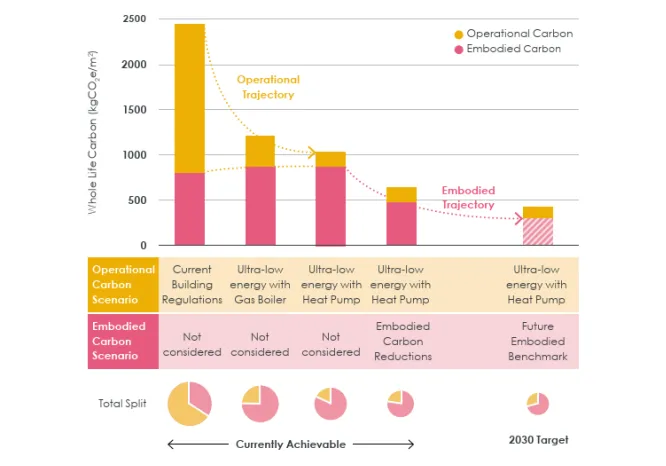
Operational and embodied carbon trajectories. As operational emissions are reduced in new buildings, the proportion of embodied carbon emissions becomes higher. The gas boiler scenario is shown only for illustrative purposes . Moving away from fossil fuels (e.g. gas) is essential in achieving net zero carbon (Source: LETI).
Current Policy Gaps and Recommendations
In December 2023, the UK government released a consultation on the Future Homes and Buildings Standard, which promises new buildings will produce 75–80% less carbon emissions by 2025 compared to those built under 2021 regulations. However, this consultation fails to address embodied carbon, despite recommendations from the CCC. The Environmental Audit Committee (EAC) has urged the government to introduce mandatory whole-life carbon assessments and establish a national standard for these evaluations.
Industry and Local Authorities’ Role in Climate Action
The construction industry has long advocated for the inclusion of embodied carbon in building regulations. Proposals such as “Part Z,” developed by industry experts, aim to introduce these regulations. Local authorities play a crucial role in bridging the policy gap by setting local planning policies that address both operational and embodied carbon. Essex, for example, has developed policies that exceed national regulations, focusing on reducing carbon emissions through local planning and construction practices.
Essex’s Climate Action and Embodied Carbon Policy
Essex County Council, guided by the Essex Climate Action Commission (ECAC), has committed to achieving net zero by 2050. The county’s Climate Action Plan includes initiatives like the Climate and Planning Unit (CaPU) to support local authorities in developing climate-focused planning policies. The ECAC has recommended that all new buildings granted planning permission be carbon positive by 2030, with policies targeting both operational and embodied carbon to meet these ambitious goals.
2. What is Embodied Carbon?
Understanding Embodied Carbon in the Carbon Context
Embodied carbon refers to the greenhouse gas emissions associated with the production, transport, maintenance, and deconstruction of building materials. It is assessed through various boundaries and measured in terms of tonnes of CO2 equivalent (tCO2e), normalized to kilograms per square meter (kgCO2e/m²). This section explains the key boundaries of embodied carbon and their relevance to planning policy.
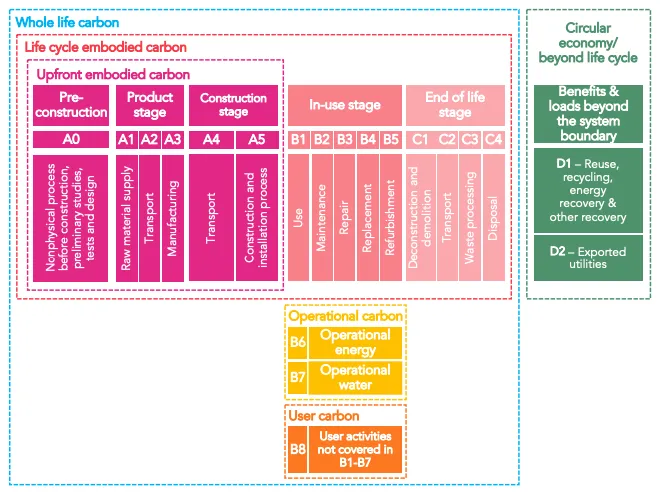
Modular information for the different boundaries of the building assessment. This version of the diagram is adapted from a combination of the diagram from the BS EN 15978, RICS 2023 and LETI.
Upfront Embodied Carbon
Upfront embodied carbon encompasses the emissions generated during the material and construction stages, including raw material supply, manufacturing, transport, and the construction of building elements. Designers have the most control over reducing upfront embodied carbon during the planning and design stages by optimizing building design and selecting low-carbon materials. This stage is crucial for setting benchmarks and targets within planning policies, as it is most easily influenced by policy and design decisions.
Life Cycle Embodied Carbon
Life cycle embodied carbon includes both upfront embodied carbon and the emissions associated with the building’s use, maintenance, replacement, and end-of-life processes, such as demolition and waste disposal. While design teams can influence these factors, building owners and occupants, who maintain and refurbish the building, play a significant role. Incorporating life cycle embodied carbon into planning policy is more complex and may require qualitative approaches rather than strictly quantitative targets.
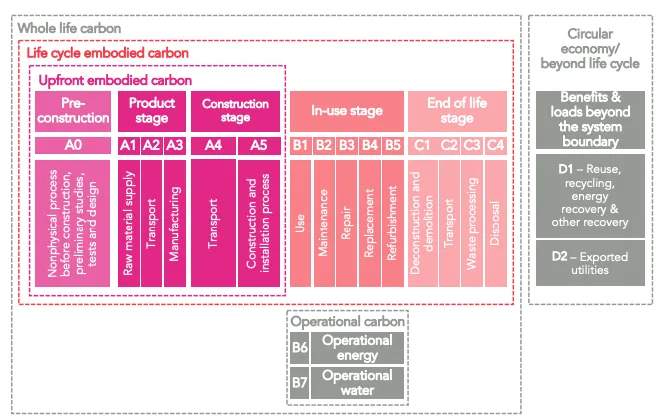
Building assessment modules with a focus on life cycle and upfront embodied carbon. This version of the diagram is adapted from a combination of the diagram from the BS EN 15978, RICS 2023 and LETI.
Operational Carbon
Operational carbon refers to the emissions from energy and water use during a building’s operation. Reducing operational carbon is critical for achieving net-zero carbon buildings and can be effectively addressed through planning policies. Essex County Council has established an evidence base to support net-zero carbon policies that align with climate targets, focusing on reducing operational carbon alongside embodied carbon.
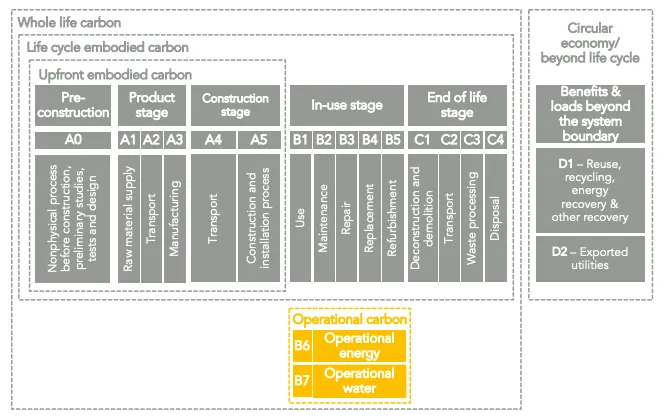
Building assessment modules with a focus on operational carbon. This version of the diagram is adapted from a combination of the diagram from the BS EN 15978, RICS 2023 and LETI.
Balancing Operational and Embodied Carbon
Decisions made to reduce operational carbon can impact embodied carbon. A balanced approach is necessary, where both operational and embodied carbon are minimized rather than trading one off against the other. Key considerations include efficient building design, appropriate use of materials, and ensuring features like shading devices and renewable energy sources are included without excessively increasing embodied carbon.
Whole Life Carbon Explained
Whole life carbon combines life cycle embodied carbon and operational carbon to provide a comprehensive view of a building’s carbon impact. While this metric is useful, it is important not to obscure poor design decisions by allowing embodied carbon to be traded for operational carbon. Current policies, such as the Greater London Authority’s (GLA) requirement for whole life carbon submissions, highlight the importance of addressing both components. Essex is considering adopting similar metrics to ensure both operational energy and embodied carbon are optimized separately.
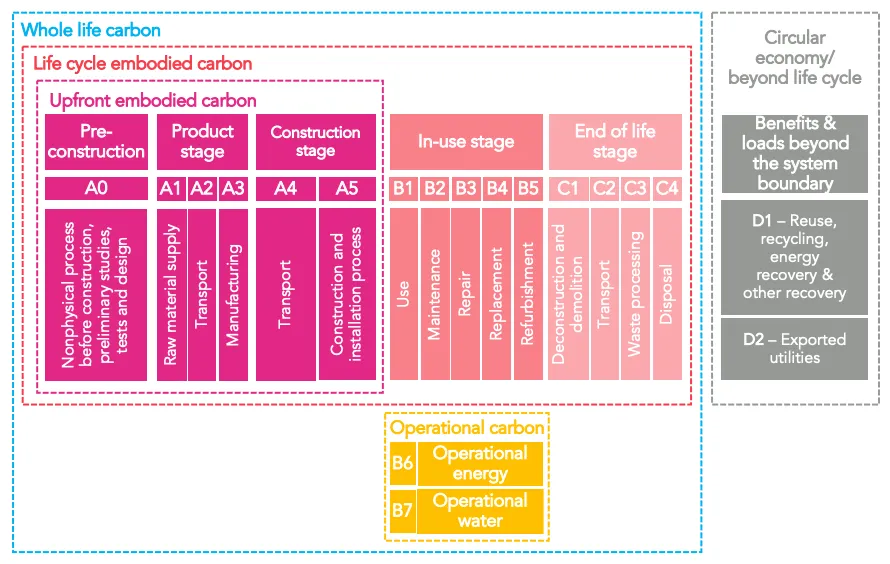
Building assessment modules with a focus on whole life carbon. This version of the diagram is adapted from a combination of the diagram from the BS EN 15978, RICS 2023 and LETI.
Circular Economy and Embodied Carbon
A circular economy aims to minimize resource depletion and waste by reusing materials and diverting them from landfills or incineration. This approach intersects with embodied carbon reduction by encouraging material reuse and recycling. While some circular economy practices may initially increase upfront embodied carbon, they can lead to significant long-term reductions by reducing the need for new materials and minimizing waste emissions. Designing for longevity and adaptability, as well as using materials with high recycled content, are key strategies in this context.

Building assessment modules with a focus on circular economy. This version of the diagram is adapted from a combination of the diagram from the BS EN 15978, RICS 2023 and LETI.
Policy Implications for Essex
Essex’s approach to carbon reduction emphasizes the separate calculation and optimization of operational energy and embodied carbon, with the potential for integrating whole life carbon assessments in the future. The adoption of policies that promote a circular economy and the careful management of embodied carbon is crucial for meeting local and national climate targets.
3. Industry Guidance on Embodied Carbon
The building industry has developed a range of guidance and standards to address the challenge of embodied carbon, ensuring that construction projects contribute to broader carbon reduction goals. This section summarizes key existing standards, industry targets, and emerging initiatives that aim to regulate and reduce embodied carbon emissions.
Existing Guidance and Standards
RICS — Whole Life Carbon Assessment for the Built Environment
The Royal Institute of Chartered Surveyors (RICS) first established a comprehensive methodology for assessing Whole Life Carbon (WLC) in the built environment with their 2017 “Professional Statement.” This document, based on BS EN 15978 principles, outlines the minimum scope required for WLC assessments, covering aspects such as demolition, construction materials, and building services. It distinguishes between sequestered carbon in materials and does not account for biogenic carbon losses from existing site vegetation.
The second edition, published in September 2023 and effective from July 2024, introduces key updates, including:
– Separate reporting for buildings within a site.
– New mandatory life-cycle stages for reporting.
– Inclusion of return trips in transport emissions.
– Alignment of carbon data with project cost plans.
– Separate reporting for carbon offsets and biogenic carbon, with sustainable sourcing requirements.
This updated methodology underpins many of the embodied carbon policy recommendations, ensuring alignment with industry standards.
Other Useful Guidance and Targets
In addition to RICS, various other bodies provide valuable guidance on embodied carbon and the circular economy:
– ISO 14040 and ISO 14044
– Royal Institute of British Architects (RIBA)
– Low Energy Transformation Initiative (LETI)
– Chartered Institution of Building Services Engineers (CIBSE)
– Building Research Establishment’s BREEAM
– UK Green Building Council (UKGBC)
– Institution of Structural Engineers (IStructE)
– Centre for Windows and Cladding Technology (CWCT) and The Concrete Centre
– Building regulations Part Z and Buildings as Material Banks (BAMB)
– UK Net Zero Carbon Building Standard (NZCBS)
Existing Industry Targets and Benchmarks
LETI and Industry Collaboration
In 2021, LETI reviewed and aligned targets from various organizations, including CIBSE, RIBA, IStructE, and the Greater London Authority (GLA). This collaboration produced the “Whole Life Carbon Alignment” paper, setting targets for upfront and life cycle embodied carbon and providing templates for consistent reporting across the industry.
RIBA 2030 Climate Challenge
RIBA has developed voluntary performance targets for embodied carbon, operational energy use, and water use, forming the basis of its 2030 Climate Challenge. These targets were established through industry consultations and are supported by a growing database of project data from participants committed to the initiative.
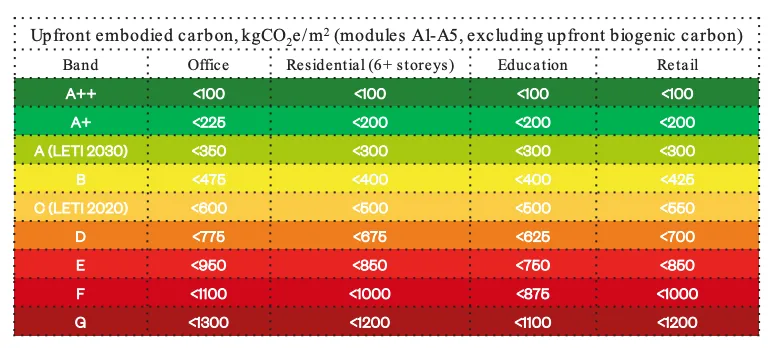
Upfront embodied carbon targets for various building typologies. The residential targets have been set based on data from 6+ storey developments, therefore the applicability to low-rise housing is unknown (Source: LETI)
Further Work in the Industry
UK Net Zero Carbon Building Standard (NZCBS)
The UK Net Zero Carbon Building Standard is a science-based initiative aimed at creating a unified approach to achieving net zero carbon in buildings. A 2023 technical study reviewed the performance levels of recent schemes concerning upfront embodied carbon, providing a significant dataset across multiple building typologies. However, the study acknowledges limitations in data quality and comparability. Once developed, the NZCBS could influence future policy, similar to existing certification standards like BREEAM.
Emerging Proposals: Part Z and the Net Zero Carbon Building Standard
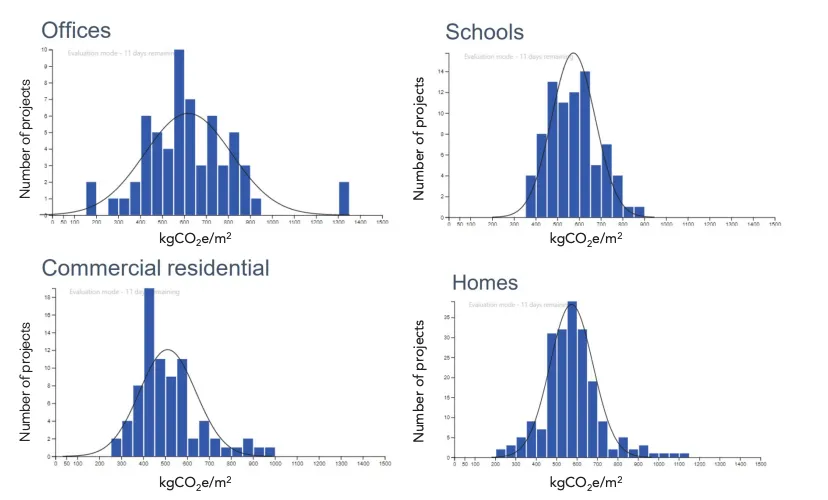
Upfront embodied carbon case study analysis (Source: Net Zero Carbon NZCBS)
Part Z — Regulating Embodied Carbon
Part Z is a proposal aimed at embedding whole life carbon assessments and embodied carbon targets into UK building regulations. This framework provides a clear methodology for developers to measure carbon performance throughout a project’s lifecycle, including post-planning stages. Part Z seeks to set reasonable standards quickly, allowing local authorities to push policy further if needed.
Net Zero Carbon Building Standard — A Unified Industry Approach
The Net Zero Carbon Building Standard, currently being developed, represents the most comprehensive cross-industry effort to establish a net zero carbon standard. The standard draws on a wide range of data sources and aims to set definitive limits for different building types. While it is still under development, it could eventually become a policy benchmark similar to BREEAM, influencing both local authorities and national regulations.
Balancing Ambitious Policies with Practical Implementation
Introducing ambitious planning policies to address embodied carbon is challenging, as there is a risk of poor-quality developments continuing unchecked. Incremental implementation, as proposed by Part Z, and setting both aspirational and minimum standards could help mitigate this risk. By gradually raising these standards over time, the industry can encourage good development practices while phasing out the worst practices.
4. Embodied Carbon in Design and Planning
Pre-Planning and During Planning — Policy and Design
Local Plans can play a crucial role in setting planning policies that guide design decisions to reduce embodied carbon in buildings. A significant reduction in upfront embodied carbon can be achieved through strategic design choices, such as lean design strategies. These strategies involve designing buildings to use less material, which reduces the need for high embodied carbon materials, such as optimized structure and foundations, minimized use of metal components in façades, and reduced reliance on plastics and refrigerants in building services. The Essex Design Guide can provide guidance on embodied carbon, helping applicants consider the impact of their design choices.
Post-Planning — Policy and Design
Once the building design has been optimized to reduce upfront embodied carbon during the pre-planning phase, the focus of policies and conditions should shift to verifying that the planning commitments are being met. This includes ensuring that embodied carbon reductions are achieved during the detailed design, specification, and procurement phases.
Design Guidance
Practical guidance in the Essex Design Guide is essential for supporting design teams in achieving embodied carbon reductions alongside net zero operational policies. This guidance should be straightforward, visually clear, and include illustrations and key notes. It should be used as a foundation for project discussions, brief settings, design reviews, and pre-planning or post-occupancy audits. While the guidance will need to be tailored to each project, it can showcase exemplary techniques for reducing embodied carbon.
Measuring and Reporting Embodied Carbon
The measurement of embodied carbon is governed by the RICS Whole Life Carbon Assessment for the Built Environment, which adapts the BS EN15978 international guidance to the UK context. The second edition, released in 2023 and effective from June 2024, aims to ensure consistent and robust measurement and reporting of embodied carbon. It provides guidance on:
– Conducting assessments at various design stages and selecting appropriate data.
– Breaking down a building into elements for measurement, benchmarking, and carbon emission reduction.
– Measuring different project types and scales.
– Accounting for different life cycle stages.
– Addressing uncertainty in measurements.
– Reporting results consistently.
Units of Measurement
Embodied carbon is reported either as a total in tonnes of CO2 equivalent (tCO2e) or normalized to kilograms of CO2 equivalent per square meter (kgCO2e/m²). The CO2 equivalent (CO2e) metric expresses the impact of all greenhouse gases on a carbon dioxide basis. Upfront carbon refers to the emissions released up to the building’s Practical Completion, while in-use and end-of-life stages are based on a 60-year Reference Study Period for buildings to ensure industry consistency. Materials are also assigned a serviceable life as defined by RICS.
Reporting
The second edition of the RICS 2023 standard includes standardized reporting templates for presenting embodied carbon results. These templates enable the comparison of figures across the industry and could be useful as a policy implementation measure.
Influence on Policy
A critical consideration for policy development is whether to require reporting solely on embodied carbon or to include Whole Life Carbon, incorporating the impact of operational emissions as well.
Measuring Upfront Embodied Carbon — Materials and Quantities
Upfront embodied carbon for a specific material is calculated by multiplying the material’s embodied carbon rate by the quantity used. Materials involved in the superstructure and substructure of a building are typically used in large quantities, meaning their selection has a significant impact on the overall upfront embodied carbon. While using a material with a high embodied carbon rate may be acceptable if used in small quantities, when large quantities are involved, it is advisable to explore lower carbon alternatives to reduce the building’s overall carbon footprint.

These are Danish figures and are not intended to be used in the UK, but the hierarchy is useful as an illustration. The material selection pyramid illustrates high embodied carbon materials at the top and low embodied carbon materials at the bottom (module A1-A3, based on global warming potential). Follow link www.materialepyramiden.dk to see the pyramid in more detail.
Reducing Embodied Carbon Through Design and the Impact on Capital Cost
Reducing the upfront and life cycle embodied carbon of a building does not necessarily lead to higher capital costs. In fact, strategies such as lean design and circular economy principles can lower capital costs by reducing the volume of materials needed and decreasing the frequency of maintenance. Additionally, these strategies can enhance the building’s versatility for multiple uses. When planning policies set embodied carbon targets, they may inadvertently restrict material selection. Therefore, any targets or benchmarks should be carefully reviewed to ensure they are ambitious but not overly restrictive.
Structural Lean Design
The sub-structure (e.g., foundations) and super-structure (e.g., beams, columns, finishes, and windows) often account for more than 50% of a building’s upfront embodied carbon emissions. Lean structural design can reduce the total material volume used in a building, including lighter foundations. Key considerations include optimizing structural grid spacing, strategic placement of service cores (e.g., staircases, elevators), reducing structural depth, and minimizing cantilevers (e.g., projecting balconies). These design choices can also result in capital cost savings.
Architectural Lean Design
Façades contribute to 15–20% of a building’s upfront embodied carbon emissions. Lean façade design considerations include minimizing the use of metal components, optimizing the glazing-to-wall ratio, and using multi-purpose façade elements. While reducing window areas can lead to capital cost savings, it may also increase upfront embodied carbon. Therefore, a balanced approach to wall-to-window ratios is essential.
Building Services Lean Design
Building services, though having a less defined impact on upfront embodied carbon, are constructed from high-carbon materials (e.g., metals, plastics, refrigerants) that are often replaced multiple times throughout a building’s life. To reduce the use of these high-carbon materials, considerations include implementing passive measures, optimizing duct design, and selecting appropriate refrigerant specifications. Reducing the capacity of building services can lead to both capital cost and space savings.
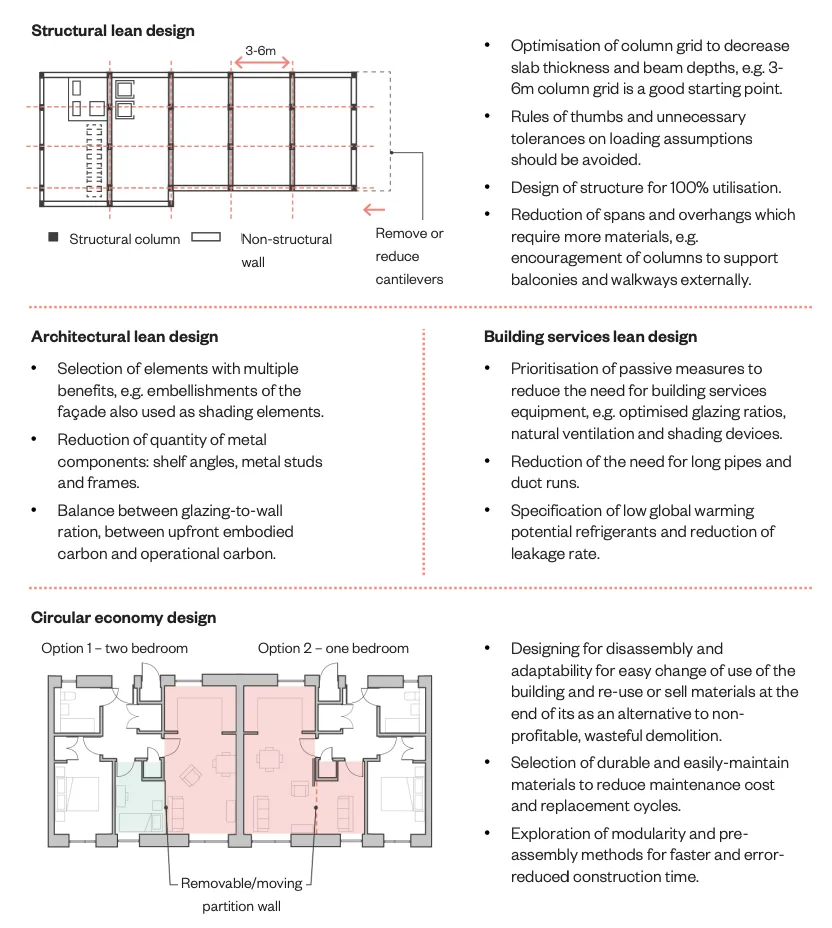
Key lean and circular economy design considerations for the reduction of upfront and life-cycle embodied carbon.
5. Review of current embodied carbon policies
Greater London Authority — Whole Life Carbon
Introduction of Embodied Carbon in Planning Policy
Embodied carbon is increasingly being incorporated into planning policies by local authorities, with several key examples emerging across the UK. These policies aim to:
– Prevent demolition and re-building.
– Reduce embodied carbon, whether life cycle or upfront.
– Require reporting of whole life carbon against established benchmarks.
– Mandate circular economy statements.
Greater London Authority (GLA) Policy
The Greater London Authority (GLA) has implemented Policy SI 2 in the London Plan (2020), which requires large-scale, referable developments to calculate both embodied carbon and whole life-cycle carbon emissions. This policy mandates the submission of both decarbonized and non-decarbonized Whole Life Carbon emissions. In 2022, the GLA published Whole-Life Carbon (WLC) assessment guidance, which includes benchmarks for life cycle and upfront embodied carbon. These benchmarks serve as reference points, not as mandatory targets. The guidance also provides a template to aid in the submission of WLC data, with the goal of collecting sufficient data to set future policy targets.
Challenges in Calculation and Reporting
Early reviews of WLC assessment submissions to the GLA have revealed issues with the granularity and transparency of data, making it difficult to compare emissions across different developments. The GLA’s policy follows the RICS Professional Statement (PS) 2017 methodology, which allows for WLC data to be reported per development. However, the RICS PS 2023 standard, which includes more detailed reporting requirements, could improve the granularity and transparency of these calculations. Design features like basements, podiums, and mixed-use developments can skew upfront embodied carbon emissions, and without clear reporting of these features, the usefulness of WLC data is limited.
Greater London Authority — Circular Economy
Policy on Circular Economy
Policy SI 7 of the London Plan addresses waste reduction and the circular economy. For large-scale projects referable to the Mayor, the policy requires a circular economy statement and a completed data schedule. This information must be provided at various stages, including pre-application, outline, detailed application, and post-construction. The policy mandates a pre-demolition audit for existing buildings and sets specific targets for waste management:
– A minimum of 95% demolition waste diverted from landfill.
– A minimum of 95% excavation waste diverted from landfill.
– A minimum of 95% construction waste diverted from landfill.
– A minimum of 65% municipal waste recycled by 2030.
– At least 20% of building elements should have recycled content.
For new materials, detailed descriptions are required for each building element against the circular economy principles. This includes scheduling material types and weights alongside an embodied carbon analysis, and key indicators for specific life cycle stages, such as material use intensity, construction waste, recycled content, lifespan, and end-of-life scenarios.
Central Lincolnshire — Embodied Carbon
Policy on Embodied Carbon
Central Lincolnshire updated its Local Plan in 2023 to include a policy on embodied carbon. The policy encourages reducing embodied carbon without setting specific targets, instead requiring a qualitative assessment. Initially, applicants are not required to use lower embodied carbon materials but must demonstrate consideration of available opportunities and options. By 2025, applicants will need to show how their design and material choices respond to embodied carbon considerations. The policy also includes a “presumption against demolition,” requiring full justification if demolition is proposed. This policy approach is shared by the three councils within Central Lincolnshire: the City of Lincoln, North Kesteven, and West Lindsey, which collaborate on a joint Local Plan.
City of London and South West Net Zero Hub — Embodied Carbon
City of London Corporation
The City of London Corporation’s City Plan 2040, currently undergoing committee approval, includes policies for retaining and retrofitting existing buildings and requiring whole life carbon assessments for major developments. The plan is expected to be adopted in summer 2025. A supplementary Carbon Options Guidance document provides a structured approach to comparing retrofit and rebuild scenarios, ensuring consistency in reporting carbon emissions.
South West Net Zero Hub
The South West Net Zero Hub offers strategic and technical support for public sector and community projects aimed at achieving net zero energy. Their report, “Net Zero New Buildings — Evidence and Guidance to Inform Planning Policy,” recommends policy requirements such as conducting embodied carbon assessments, reporting against industry benchmarks, and using assessment data to inform target setting.
City of Westminster — Retrofit Over Demolition and Circular Economy
City of Westminster Council
In November 2023, Westminster Council introduced a draft policy prioritizing retrofit over demolition. The policy requires an optioneering exercise to assess the carbon cost and public benefit of refurbishment, retrofit, deep retrofit, or redevelopment options, with redevelopment being discouraged. All major developments, including those involving demolition, must meet LETI or RIBA 2030 embodied carbon targets. The policy also includes requirements for circular economy practices and adaptability for buildings subject to substantial or total demolition. To ensure compliance, Westminster City Council developed a Circular Economy Policy Compliance Checklist and supporting documents like the Westminster Embodied Carbon Evidence Base and Retrofit First Topic Paper.
Bath and North East Somerset — Embodied Carbon
Policy SCR8 on Embodied Carbon
Bath and North East Somerset Council introduced the UK’s first Net Zero Carbon policy in January 2023, covering both operational and embodied carbon. Policy SCR8 mandates that all major developments submit an upfront embodied carbon assessment, demonstrating that less than 900 kgCO2e/m² can be achieved. No carbon offsetting is allowed, and non-compliant developments must provide valid justification with supporting evidence. The policy is set to be updated based on findings from the West of England Embodied Carbon Evidence Base.
Bristol — Whole Life Carbon, Retrofit Over Demolition, and Circular Economy
Bristol City Council
Bristol City Council’s 2023 Local Plan publication includes policies on embodied carbon, materials, and circular economy practices. Major developments are required to conduct an embodied carbon assessment (A1-A5, B1-B5, C1-C4) and meet specified minimum targets. Where these targets are not met, carbon offsetting is required. The plan also offers general guidance on reducing embodied carbon and implementing circular economy principles in building design.
Summary of existing embodied carbon policies and approaches in UK
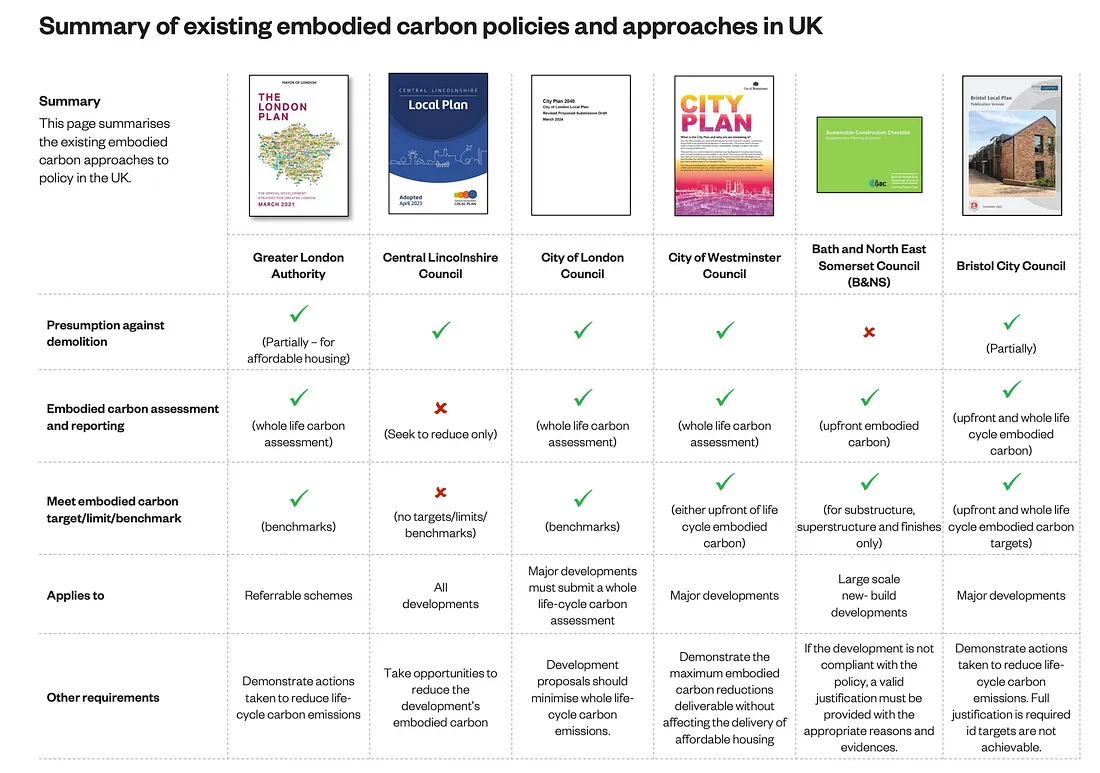
Summary of existing embodied carbon evidence-base reports in the UK

6. Policy recommendations
Types of Policy Requirements
To effectively encourage a reduction in embodied carbon through thoughtful decision-making and design, a range of policy requirements should be considered. These requirements should include a mix of qualitative and quantitative measures to achieve optimal outcomes.
Qualitative Requirements
Qualitative requirements can address a broader range of embodied carbon issues and encourage best practices. These requirements may include:
– Retaining existing buildings: Prioritizing the reuse and retrofit of structures over demolition.
– Promoting good design: Focusing on designs that inherently result in lower embodied carbon.
– Disclosure of options: Requiring developers to disclose the design options they considered, including basic levels of embodied carbon analysis.
– Encouraging circular economy practices: Promoting the reuse of materials and minimizing waste.
These qualitative policies offer flexibility, allowing them to be applied across a variety of developments while promoting best practices.
Quantitative Requirements
Quantitative requirements involve using specific metrics to limit the embodied carbon of developments. These requirements can be applied to measurable items such as:
– Upfront embodied carbon: The carbon emissions associated with materials and construction before the building is operational.
– Life cycle embodied carbon: The total carbon emissions over the entire lifecycle of a building.
– Whole life cycle carbon: Combining both operational and embodied carbon over the building’s lifespan.
Developers would compare these metrics to benchmarks or targets and might be required to meet specific limits or perform better than set thresholds. Quantitative benchmarks are particularly effective in preventing worst practices while allowing some design flexibility to accommodate challenges such as poor ground conditions or the need to use specific materials to meet other planning requirements.
Summary of Proposed Policy Requirements
The proposed policy requirements focus on four key areas:
1. Presumption Against Demolition and Promoting Circular Economy: Encouraging the retention and reuse of existing buildings and materials.
2. Lean Building Design and Material Efficiency: Promoting designs that minimize material use and reduce embodied carbon.
3. Reducing Upfront Embodied Carbon: Setting limits on the carbon emissions associated with the initial construction phases.
4. Reporting Whole Life Carbon: Requiring comprehensive reporting on carbon emissions throughout the entire life cycle of the building.
For each policy requirement, the following aspects are outlined:
– Types/Scale of Development: Defining which types of projects the requirement applies to.
– Timescale of Implementation: Setting timelines for when the policies will take effect.
– Intention: Clarifying the goals behind the policy.
– Proposed Requirement Wording: Providing specific language for the policy.
– Success Criteria: Determining how the success of the policy will be measured.
– Submission Requirements: Detailing what developers need to submit at various stages (pre-application, planning submission, and discharge of condition).
– Supplementary Guidance: Offering additional resources and guidelines to support policy implementation.
7. Implementation
Implementation of Policy Requirements
The primary goal of an embodied carbon planning policy is to reduce the embodied carbon emissions associated with buildings without making the planning process unnecessarily burdensome for applicants or planning teams. This section outlines recommendations for implementing the policy, including the use of checklists, report content guidelines, and the completion and review of the RICS reporting template. The policy envisions that a single written report, including calculation results, will be submitted at the planning application stage. This report would be a condition of approval, ensuring that the development is constructed in accordance with the agreed-upon plan. This report could be integrated into a broader “Energy and Carbon Statement” that addresses both net zero operational and embodied carbon policies.
From the Planning Officer’s Perspective
For planning officers, the information needs to be straightforward and clearly presented to facilitate easy comparison against policy requirements. Checklists and guidelines on interpreting the RICS reporting template can aid in this process. While introductory training on embodied carbon could be beneficial, it is not essential for planning officers to assess applications effectively.
From the Applicant’s Perspective
For applicants, the following tools and guidance are recommended:
– Contents List for Reports: This will help keep reports concise and aligned with what the local authority expects, providing clarity on the necessary components.
– Checklist: A checklist will guide applicants on how to describe the steps taken to reduce embodied carbon and ensure that all necessary information is included.
– RICS Template Guidance: Clear instructions on which sections of the RICS template to complete will ensure that the correct scope of embodied carbon is calculated and submitted.
Additionally, design guidance should be provided to help applicants reduce embodied carbon effectively. It is recommended that this evidence base be supplemented with user-friendly guidance, potentially included in the Essex Design Guide.
Policy Implementation
Policy requirements 1 and 2 focus on reporting to demonstrate compliance, while requirements 3 and 4 are centered on ensuring that quantitative limits have been met. The following pages provide useful tools and resources to support the effective implementation of these policies.
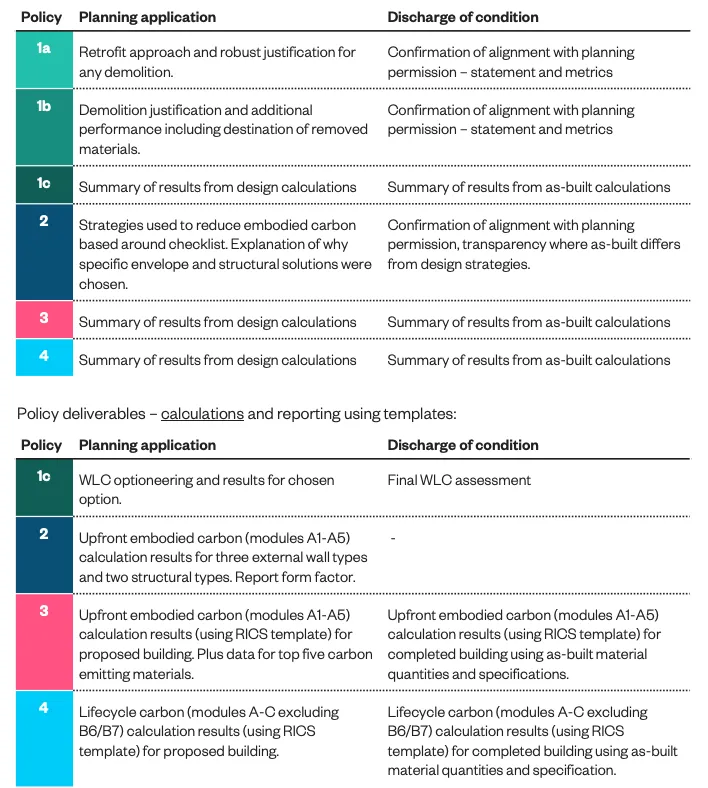
Policy deliverables — single written report at planning and discharge stage
8. Upfront embodied carbon modelling for policy
Purpose of upfront embodied carbon and cost analysis
The purpose of this modelling analysis is to investigate the upfront embodied carbon (modules A1-A5) for three residential building typologies. The results have been used to inform the proposed upfront embodied carbon target policy. Capital cost modelling has been carried out to understand how cost and viability may affect policy. Supplementary life cycle embodied carbon calculations have also been carried out.
Context — Essex domestic building stock
A review of the data collected from the 2021 census showed the most common residential types in Essex to be the semi-detached (32%) and detached houses (31%). The remainder were terraced houses (21%) and flats, maisonettes or apartments (17%). In addition, the data collected from Chelmsford Garden Community illustrates that common home sizes at outline planning application stage are 2 bedroom (38%) and 3 bedroom (34%). The data from the census and example data from the representative development in Chelmsford have been used to inform the selection of building typologies modelled for this evidence base.
Essex net zero policy
The local authorities in Greater Essex have worked collaboratively through the Essex Planning Officers Association and with funding from the Essex Climate Action Commission to establish a robust evidence base and common planning policy approach for net zero carbon development (in operation). The policy proposes that all new buildings should be designed and built to be Net Zero carbon in operation and must demonstrate compliance with the following:
Requirement 1: A space heating demand limit
Requirement 2: Be fossil fuel free
Requirement 3: An energy use intensity (EUI) limit
Requirement 4: An on-site renewable energy generation balance
Requirement 5: Provide as-built performance confirmation and in-use monitoring
Requirement 6: Use energy offsetting as a last resort All embodied carbon modelling in this evidence base has been carried out on the assumption that the designed dwellings meet net zero operational policy requirements 1–4.
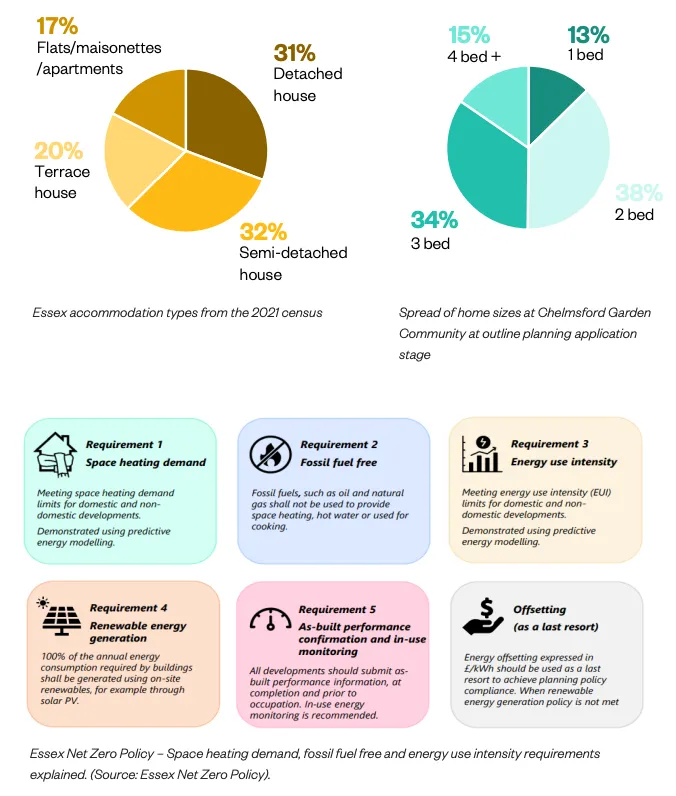
Conclusion
Addressing embodied carbon is essential for the construction industry to contribute to the fight against climate change effectively. The policies and recommendations outlined in this study provide a comprehensive framework for reducing the carbon footprint of new developments. By incorporating these strategies into planning and design processes, the industry can make significant strides toward sustainability. Implementing these policies will not only help meet climate goals but also set a new standard for environmentally responsible construction practices.
2050 Materials’ Role in Reversing Climate Change
2050 Materials has been dedicated to transforming product data and sustainability into a single platform, enabling the construction industry to make data-driven decisions at any project stage.
By launching the 2050 Materials API — a powerful tool that integrates comprehensive climate data into your design and construction workflows, we enable AEC companies and others to accurately estimate a building’s environmental impact, driving sustainability from the ground up.
How is this related to the study?
By using the 2050 Materials platform & API, you can do much more than find beautiful and sustainable building materials, you can use white-papers, policy papers, and industry guidance documents to generate multiple scenarios of your project making sure you choose the one most sustainable.
The data from policy reports like this one is available directly on our platform, where we’ve made it actionable and accessible for all users in a structured format. You achieve this by first extracting the data, importing it into an Excel file, and then integrating it into the 2050 Materials database. This innovative process ensures that, as a user, you can seamlessly access and utilize important data from reports for scenario modeling through our projects tool or API.
Here’s a post that elaborates more on the topic, we included a step by step video on the process below.


If you need any help or you’re interested in knowing more, reach out to us on api@2050-materials.com.
Sources
Essex Embodied Carbon Policy Study — Essex Design Guide
Climate Emergency Design Guide — LETI
Addressing global warming — Climate Action Tracker
Whole life carbon assessment (WLCA) for the built environment — RICS
Related articles

Climate-Resilient Materials for the Built Environment: A Data-Centred Prime
As climate volatility intensifies, resilience metrics are fast becoming as critical as carbon data in material selection. This article outlines why adaptation is now a design imperative, how materials can be evaluated through a systems lens, and what KPIs project teams should demand. From self-healing concrete to fire-rated façades, we present a structured taxonomy of resilient materials, explain how to embed this intelligence into digital design workflows, and propose next steps for specification, benchmarking, and procurement.
Read more
The Most Interesting Low Carbon Products in Office Design
In this article and collection, we highlight 11 outstanding products that contribute to a lower carbon footprint in office design.
Read more
Top Low Carbon Building Boards: Performance, Benefits, and Use Cases
The building boards highlighted in this article and collection showcase low-carbon innovation in modern construction.
Read more